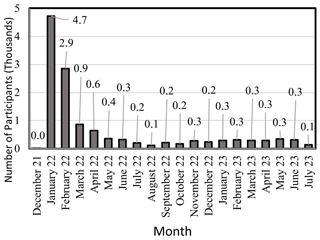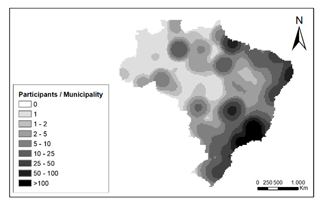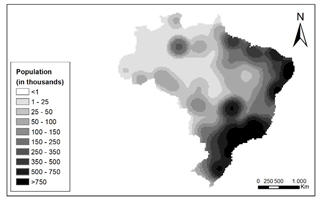the Creative Commons Attribution 4.0 License.
the Creative Commons Attribution 4.0 License.
Building disaster prevention capacity in a continental scale country: the trajectory and experience of the Geological Survey of Brazil
Leandro G. Kuhlmann
Mamoru Miyamoto
Julio C. Lana
Tiago Antonelli
The goal of this paper is to share the trajectory and current results of the training program on disaster risk reduction from the Geological Survey of Brazil (GSB) as well as the challenges and perspectives for future development. The risks faced by a society are determined by the hazards presented by nature and by the cultural norms of how society decides to deal with them. Historically Brazil has had spontaneous urban growth, which led to the occupation of naturally hazardous areas. The National Plan of Protection and Civil Defense Act of 2012 led to an increase in responsibility of the central government to support local governments in disaster prevention. In 2007 the SGB established its training program for disaster prevention capacity building, and a decade and a half later around 3500 people have received entry level education in risk management. Due to the restrictions imposed by the COVID-19 pandemic, the SGB implemented distance learning courses, with significant impact.
- Article
(747 KB) - Full-text XML
- BibTeX
- EndNote
In the international literature, the term “Geological Risks” is usually restricted to earthquake and volcanic risks, however the Geological Survey of Brazil (SGB) uses the term to a broader extent including flood and sediment disasters (Sampaio et al., 2013), which was chosen in this paper to keep coherence with the institutional decision.
In 2006 two geologists and one engineer from the SGB promoted the first Geological Risks Perception Course (GRPC) through a pioneer partnership with the Municipality of Nova Friburgo/RJ, which included a training program for local officials, technical contributions for the Municipal Plan for Risk Reduction and an educational booklet for children and teenagers. In 2012 the Law 12.608 brought substantial modifications to the disaster management in Brazil (Sampaio et al., 2013). Those modifications led to an increase in the responsibilities of the National Government and subsequentially to the SGB. The general curriculum of the original GRPC was adapted into a permanent project with a team. Eventually around 15 people engaged in the GRPC, while still doing other activities such as risk and hazard mapping. The organization of classes for the GRPC often depended upon support from various local and regional Civil Defense Offices and their internal capabilities.
Reinforcing capacity at the national and local levels is considered central a major factor in disaster preparedness (Matsuoka, 2016). Sharing the expertise and the experience in capacity development is expected from the international community as a contribution to implement the Sendai Framework worldwide (Koike et al., 2018). The goal of this paper is to share the expertise and experience of the SGB in the capacity building in Brazil.
2.1 Legal framework of the courses
The National Plan for Protection and Civil Defense (Law 12.608/2012) defines the responsibilities of each sphere of government. Brazil has a Central Government, 27 states (including the Federal District) and a total of 5570 municipalities, with a median population for of 11 732 people (Brazilian Institute for Geography and Statistics, 2021).
The Municipality level holds the greater authority in terms of DRM. The National Government is responsible for supplying financial and technical support to State and local governments through courses, risk mapping and others.
The main legal instruments responsible for turning general governmental directives into concrete measures and services are the Multi-annual Plan and the Annual Budget Law. Since the year of 2012, those instruments comprise the Governmental Action 20LA, that allocates the budget and responsibility to the SGB to provide educational material and courses in DRR; the Budget Law also defines that the courses should be directed to public managers, public servants and for the population in general.
2.2 The characteristics of the Municipality Civil Defense Offices
The Project Elos (National Secretariat for Protection and Civil Defense, 2021) supplied a comprehensive range of statistics that describe the profile of the Municipality Civil Defense institutions (MCDs). The report highlights the challenges faced by the Municipalities such as being undermanned, undertrained, underequipped, and commonly hiring through nominations, a choice often criticized because of the vulnerability of such nominees to political instability (Lopez and Praça, 2018).
Even in developed countries, the smaller municipalities are often found lacking in capacity to manage all facets of disaster management (Ubaura, 2017). In Brazil, the large number of municipalities, with small populations and scarce resources, make it unlikely that most of them would have financial or managerial resources to hire highly skilled professionals, those able to deal with the complexity of the studies necessary and with the political acumen to navigate the intricate system of governance to implement technical solutions.
Brazil is the 5th largest country in the world, the distribution of thousands of municipalities in the continental scale country poses a challenge to the mission of the SGB, to provide training courses for those authorities. Not only some locations are remote and have difficult access, but they are also unique in terms of their needs due to their highly variable social and physical characteristics. While certain municipalities are used to slow paced floods of mega rivers, others might be in mountainous areas or in a part of the coastline with strong interference of the tidal effects.
3.1 The Standard GRPC
The Geological Risks Perception Course – GRPC is structured to provide basic knowledge on the process of flood disaster and sediment disaster and is divided into four modules. In the first module, the GRPC explains the basic terminology, where concepts such as risk, hazard, and susceptibility. Simple examples are provided for the students to understand how to differentiate such classifications.
In the second module the course presents the concept of flooding, which is explained as part of a natural geological process. The GRPC presents the hydrological cycle using the examples of geomorphological patterns that usually occur across a fluvial system: from a river's steep headwaters and their valleys sculpted by erosion down to their flat river mouths overflowing with sediments. The concept of return periods and flood frequency is presented in a simplified manner, to provide understanding of the logical aspect behind occurrence of extreme events.
In the third module the GRPC presents the contents on risks associated with erosion. The GRPC presents examples of the geomorphological features of ravines, gullies, rivers, and coastal erosions. The goal is to allow the student to be able to identify erosional processes and understand their dynamic nature.
The fourth module concerns landslides and debris flow. The GRPC presents concepts and examples of the processes of landslide and debris flow. The GRPC focuses not only on the typical geomorphological settings of landslide prone areas but also on the inadequate construction methods that are popular in Brazil, such as cut and fill on steep slopes, without the supervision of a professional.
The fifth module focuses on hard and soft measures in disaster prevention. The GRPC presents a broad, simplified view of the types of construction works that can be considered as alternatives for risk reduction and disaster mitigation. The GRPC also presents soft measures such as alert systems, evacuation drills and community engagement are also presented.
The sixth module is an explanation on how SGB uses those concepts to map high and very high-risk areas. The methodology of the risk sectoring is quite simple and intuitive and is based mostly on visual identification of signs of terrain instability for landslides and interaction with local populations for floods. While certain projects of the SGB incorporate numerical modelling, they are not presented by the GRPC due to their complexity. The objective is to encourage local public officials to prepare their own assessments, instead of continuously requesting support from the central government as their main strategy.
Lastly, the seventh module involves how to read and understand the risk assessments provided by the SGB and using the information to pursue approval of local policies that strengthen the community against natural hazards.
3.2 The Fully Asynchronous Course – FAC
The pandemic of COVID19 presented profound difficulties to the continuity of the GRPC program. Travel restrictions and subsequent inability to gather the participants together completely disrupted the normal workflow of the program. The first response was an instant shift to remote classes through videoconferences. The reduced cost of remote classes and ability to organize classes made it possible to surpass the official goals in terms of both course frequency and participant numbers. The remote classes did, however, highlight the difficulty in engaging in active discussion with the participants. Subsequently and significantly, there was a feeling that the courses were less efficient in meeting their goals – primarily in terms of supplying quality education.
As the concept of distance learning gained acceptance, a partnership was successfully established by the SGB with the National School of Public Administration and allowed to host a Fully Asynchronous Course (FAC). The contents of the course stayed the same as the standard GRPC, but its presentation was simplified and made more dynamic with videos and illustrated content. The course was released by the SGB for free and is available for public servants, and for the population in general, with no prerequisites for participation.
The FAC has had an unexpectedly high number of participants that peaked soon after its release (Fig. 1) and has reached a total of 13 000 participants from December 2021 to July 2023. Of those participants, 39 % were able to successfully answer the questionnaires and acquire certification. Nonetheless, all participants are considered by the SGB as beneficiaries of the course – because of the expected results to promote a disaster resilient culture.

Figure 1Evolution of the number of Participants of the FAC course from December 2021 to October 2022.
Public servants constituted 50 % of the participants, with the other 50 % being non-governmental participants.
The spatial distribution of the participants in Brazil (Fig. 2) is aligned with the actual population distribution in Brazil (Fig. 3), with some participants even from remote areas, with difficult access. Among municipalities with a population of at least 50 000 people 87 % had at least one participant, with an average of 15 participants.
3.3 Perspectives of future development of the program
From the duties defined by Law 2012 and subsequently by Action 20LA of the Federal Government, the most important gap that remained unaddressed by the SGB was the education of government managers. There was a certain apprehension that government managers (e.g., mayors, lawmakers, secretariats, advisors) might have minimal interest in engaging in actual technical discussion. Mobilizing and gathering municipal authorities, which tend to be busy, also was always considered a greater challenge in comparison to mobilizing their technical staff. For those reasons, the SGB decided to establish another partnership, with the Getulio Vargas Foundation (FGV), a national reference in terms of public management education. The FGV was responsible for preparing the educational material, hosting the course, and issuing certificates; while the SGB supplied the financing, the general guidelines, and the final revision of the course.
The course entitled Public Policies for Disaster Risk and Response Management at Municipality Level was released in August 2023 and within the first two months had over 800 participants.
The course developed for public managers supplies not only knowledge of the legal aspects of disaster management, but also to serve as an appeal for greater engagement of local authorities in disaster prevention policies.
In the past decade, the SGB has envisioned significant efforts to address the mission presented by the National Plan of Protection and Civil Defense. Nonetheless, the employment of public servants in Municipality Civil Defense offices has a dynamic that does not tend to align and fixate them for long term careers in disaster management, therefore, the maintenance of the GRPC program, as it has been operating for the past 15 years, is not expected to be sufficient for the country's required disaster prevention education.
New strategies have been applied in the past two years and the implementation of remote learning platforms has been accepted by users. This has enhanced the ability of the small SGB team to reach more citizens and more public servants. The total number of participants from both the standard GRPC and the FAC programs correspond to 17 000 people in the past 15 years.
The initiative of supplying a dedicated course to public managers is expected to raise awareness of the importance of building strong local institutions.
The trajectory described in this paper shows how small groups or even individual initiatives may be scaled-up into significant projects that impact thousands of people.
The data used in this manuscript is publicly available from the addresses: https://www.ibge.gov.br/estatisticas/sociais/populacao/9103-estimativas-de-populacao.html?=&t=downloads (Brazilian Institute for Geography and Statistics, 2021) and https://emnumeros.escolavirtual.gov.br/dados-abertos/ (National School of Public Administration, 2023).
LGK: Conceptualization; Writing – original draft preparation; Visualization. MM: Supervision. TA: Project administration. JCL: Resources.
At least one of the (co-)authors is a guest member of the editorial board of Proceedings of IAHS for the special issue “ICFM9 – River Basin Disaster Resilience and Sustainability by All”. The peer-review process was guided by an independent editor, and the authors also have no other competing interests to declare.
Publisher’s note: Copernicus Publications remains neutral with regard to jurisdictional claims made in the text, published maps, institutional affiliations, or any other geographical representation in this paper. While Copernicus Publications makes every effort to include appropriate place names, the final responsibility lies with the authors.
This article is part of the special issue “ICFM9 – River Basin Disaster Resilience and Sustainability by All”. It is a result of The 9th International Conference on Flood Management, Tsukuba, Japan, 18–22 February 2023.
The authors would like to acknowledge the Japanese International Cooperation Agency – JICA, for promoting and financing the cooperation and partnerships that long led to the preparation of this manuscript.
The International Centre for Water Hazard and Risk Management – ICHARM, for the incentive of continuous partnerships.
The International Conference on Flood Management Ad-hoc Committee and Organizing Committee for the constant support and coverage of submission and publication charges.
The Geological Survey of Brazil, for continuously engaging in the partnerships that have made the partnerships that led to this publication.
This paper was edited by Svenja Fischer and reviewed by two anonymous referees.
Brazilian Institute for Geography and Statistics: Estimativas da Populacao Residente para os Municipios Brasileiros com data de referencia em 1 de julho de 2021, Rio de Janeiro RJ, Brazil, Brazilian Institute for Geography and Statistics [data set], https://www.ibge.gov.br/estatisticas/sociais/populacao/9103-estimativas-de-populacao.html?=&t=downloads (last access: 1 February 2023), 2021.
Koike, T., Hayashi, H., Satake, K., Tsukahara, K., Kawasaki, A., Amano, Y., Takara, K., Saya, S., Nishiguchi, N., Nishikawa, S., Tamura, K., Hiroki, K., Shaw, R., and Ikeda, T.: Role Played by Science and Technology in Disaster Risk Reduction: From Framework Planning to Implementation, J. Disaster Res., 13, 1222–1232, https://doi.org/10.20965/jdr.2018.p1222, 2018.
Lopez, F. G. and Praça, S.: Cargos de confianca e politicas publicas no Executivo federal, in: Burocracia e politicas publicas no Brasil: interseções analíticas, edited by: Pires, R., Lotta, G., and Elias de Oliveira, V., Instituto de Pesquisa Economica Aplicada, Brasilia, Brazil, 141–160, ISBN 978-85-7811-331-5, 2018.
Matsuoka, K.: Promptness and sustainability in town reconstruction following the 2011 Great East Japan Earthquake, in: Asian Law in Disasters: Toward a Human-Centered Recovery, 1st edn., edited by: Kaneko, Y., Matsuoka, K., and Toyoda, T., Routledge, 263–275, https://doi.org/10.4324/9781315680323, 2016.
National School of Public Administration: Escola Virtual em Numeros: Dados Abertos, National School of Public Administration [data set], https://emnumeros.escolavirtual.gov.br/dados-abertos/ (last access: 1 February 2023), 2023.
National Secretariat for Protection and Civil Defence: Diagnostico de capacidades e necessidades municipais em protecao e defesa civil, Technical Report, Brasilia – DF, Brazil, 83 pp., ISBN 78-65-84510-08-1, 2021.
Sampaio, T. Q., Pimentel, J., Silva, C. R., and Moreira, H. F.: A Atuação do Serviço Geologico do Brasil (CPRM) na Gestão de Riscos e Resposta a Desastres Naturais, 6th National Congress of Public Management, 16–18, National Council of State Administration Secretariats, April 2013, Brasilia, Brazil, 26 pp., https://www.consad.org.br/documentos (last access: 10 December 2023.), 2013.
Ubaura, M.: Challenges in Residents-Centered Reconstruction Process from a Major Disaster: Lessons Learned from the Great East Japan Earthquake, in: Community – Based Reconstruction of Society University Involvement and Lessons from East Japan Compared with Those from Kobe, Aceh, and Sichuan, edited by: Hokugo, A. and Kaneko, Y., Springer, Singapore, 3–13, https://doi.org/10.1007/978-981-10-5463-1, 2017.







